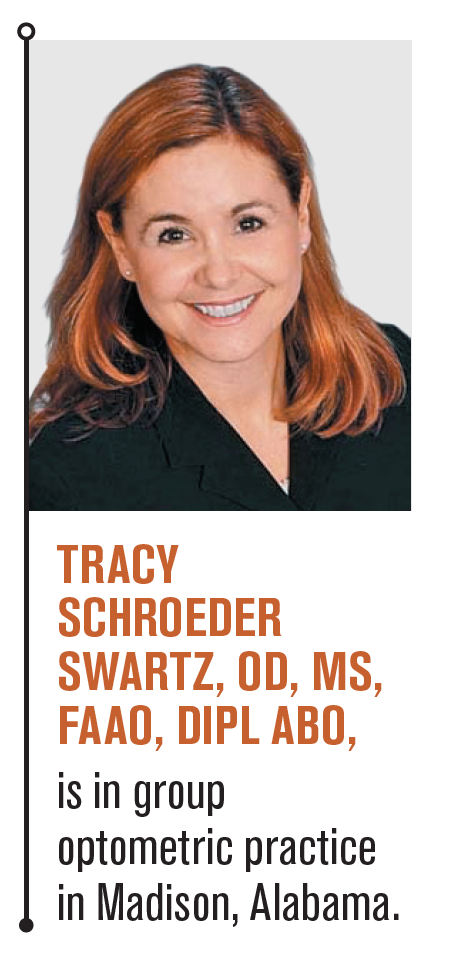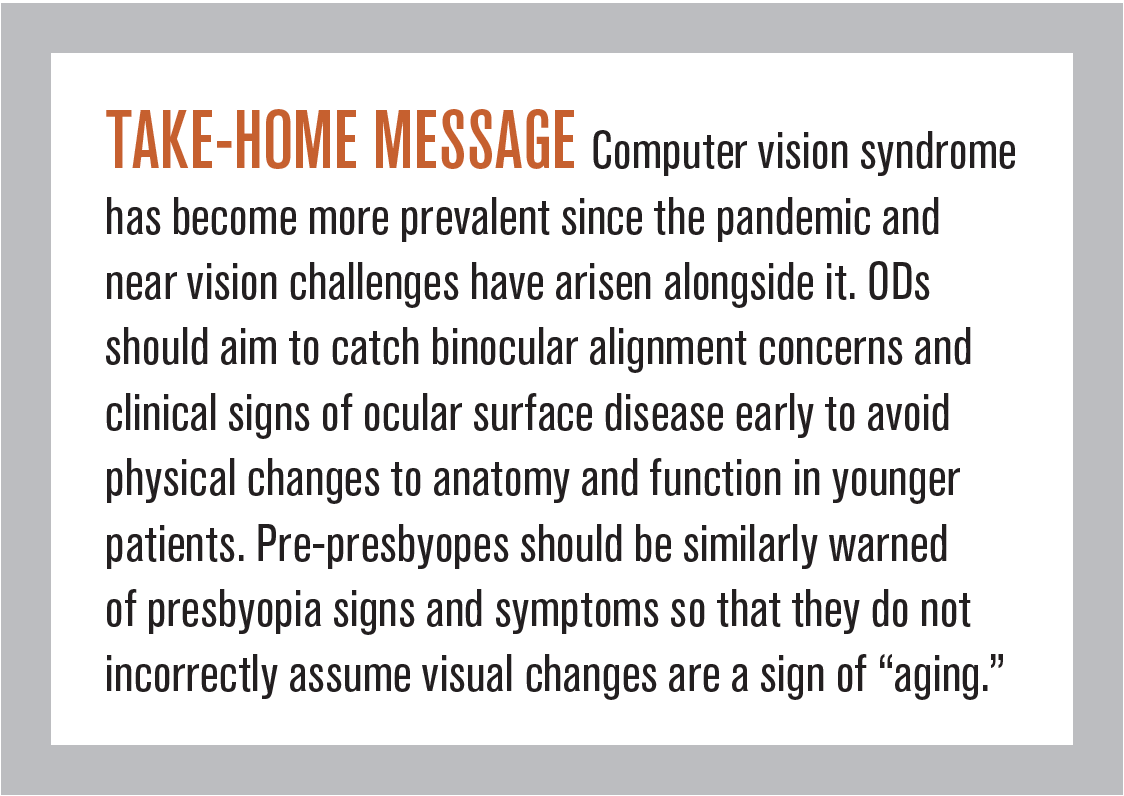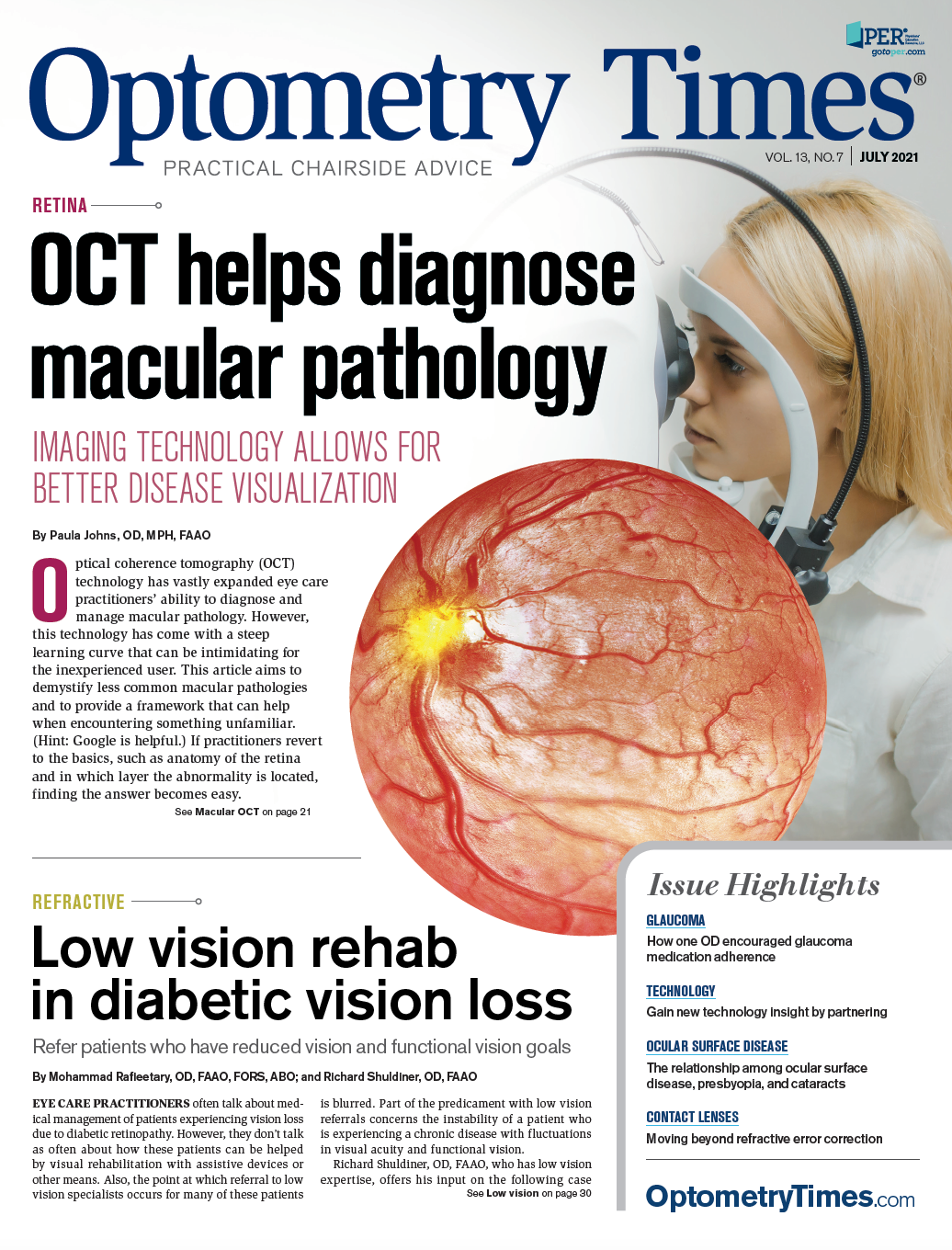The relationship among ocular surface disease, presbyopia, and cataracts
Address near vision comfort for patients of all ages, and start while they are young


The use of digital devices has dramatically increased as face-to-face interactions were prohibited by the COVID-19 pandemic. Device usage varies by age group. Baby boomers (age 54 to 72 years) use tablets more than younger individuals and are more likely to be online in the morning.1 Generation Xers get most of their news from their desktop rather than a laptop, and nearly 100% use a smartphone. Millennials own laptops but are likely to use their phone as their only internet source. Children are using laptops for school all day, and more young people are developing dry eye.
ODs used to worry about binocularity and near vision comfort in elementary school–aged children but rarely concerned themselves with near visual comfort until patients become presbyopic. Computer vision syndrome may have brought symptomatic patients to the office, but ODs rarely routinely asked about near vision challenges.
Dry eye and near vision
With a better understanding of dry eye and its relationship with lid disease combined with increased mask wear, ODs need to take better care of their patients’ near visual comfort. Rather than targeting a certain age group, consider targeting those who use digital devices. Results of a study in England prior to the pandemic showed that by age 3, 68% of children were regularly using a computer and 54% were performing online activities.2
Digital device use has been associated with dry eye.3 Five hours or more of daily video display terminal use was reported to be a risk factor for dry eye diagnosis,4 but only an hour of constant use can bring on dry eye symptoms.5 Computer vision syndrome is associated with fatigue, asthenopia, blurred vison, and less often, diplopia; it also may be combined with symptoms of ocular surface disease.
Accommodative and vergence challenges are more likely to manifest after a day staring of at the computer monitor, and are estimated to affect more than 50% of computer users.6 Many patients will assume these symptoms are normal with increased computer use and may not mention them during an eye examination, much less make an appointment to request help with them.
Eye care practitioners should now include questions about comfort with reading and computer use for patients of all ages. Stereopsis assessment and cover testing may reveal strabismus or phorias, and intermittent suppression may uncover previously undiagnosed concerns. A dry eye questionnaire may elicit complaints from patients who thought they were “fine” until their eye examination. Computer use is associated with altered blinking and horizontal gaze angle, increasing evaporative dry eye. Work environments may suffer from low humidity, drafts from ventilation fans and air conditioning, and poor air quality, which may exacerbate dry eye.7
Younger patients
Four our youngest patients, it is important that binocular alignment concerns and clinical signs of ocular surface disease are discovered at an early stage. Young patients may rub their eyes or complain of headaches on school days or report tearing or redness during allergy season.
Now eye care practitioners know that chronic inflammation must be addressed, and they need to tackle it early on rather than years later to avoid physical changes to anatomy and function. Conditions such as meibomian gland loss, trichiasis, conjunctival chalasis, pterygium, Salzmann nodules, and corneal scarring should have been addressed decades before.
Eye care practitioners must be more proactive with younger patients at risk for dry eye and discuss healthy behaviors and routine examinations. Talk to them about taking omega-3 supplements and using hot compresses as “vitamins” for eyes to develop healthy habits. I support task-specific spectacles, low plus readers, or prism. Educate parents and young adults about the benefit of computer spectacles. Additionally, tell patients about the 20-20-20 rule: Look 20 ft away for 20 seconds after 20 minutes of reading or device use.
Consider prism
Contoured prisms may be beneficial for those patients who present with complaints about reading, headaches, or eyestrain. Oddly, eye care practitioners habitually prescribe variable reading additions but rarely thought of variable prism correction until recently. Standard prism prescriptions use the same power for all distances. If the prism required for reading is 10 base in, but the patient needed only 3 base in for distance, 2 pairs of glasses were prescribed.
Variable prisms are now available to better address alignment and vergence concerns. I consider them in patients who present with computer vision syndrome and dry eye complaints when their headaches fail to resolve while other ocular symptoms improve. I am also comfortable with cover testing and jump vergence testing using a prism bar.
Contact lens wear
Remember that contact lens wearers may be more likely to experience ocular discomfort during school or workdays. Educate these patients to develop healthy habits as well.
I tell my patients who wear contact lenses: “If you plan to work for 10 hours today at the computer, you need to be proactive to be comfortable.” Encourage all contact lens-wearing patients to take breaks, use artificial tears, take fish oil, and swap contact lenses for glasses if their eyes become fatigued.
I also educate patients early about the need for reading help before they develop presbyopia. I talk about options such as multifocal contact lenses, monovision contact lenses, computer spectacles, and presbyopic treatments under development. I think that wearing multifocals increases intraocular lens (IOL) options when that patient develops cataracts. Wearing multifocals enables the patient to adapt to the nighttime concerns often reported with multifocal IOLs. I want to keep my patients in multifocal contact lenses as long as they want to wear them.
Presbyopia
Pre-prebyopes should be informed about the signs and symptoms of presbyopia so they do not assume that visual changes are a result of “aging” with no available treatment. Findings from a double-blind study indicated that spectacles to correct small refractive errors in pre-presbyopic employees would increase productivity by at least 2.5%.8
With much activity in the presbyopia space, I offer my presbyopes as many options as possible without being limited by dry eye.
It is eye care providers’ duty to discuss presbyopia treatments including eye drops, corneal treatments, and multifocal and extended depth of focus (EDOF) IOLs. These technologies require clinical assessment to determine who will do well, such as topography, retinal optical coherence tomography, and ocular surface evaluation. Practitioners do not yet know how miotic drops under investigation will affect patients with lid disease, chronic allergy, and keratoconjunctivitis sicca. Nor do they know whether presbyopic IOL function will be enhanced or reduced by miotics. However, they know that pinhole inlays, diffractive and EDOF IOLs are less effective with keratitis, tear film instability, and lid disease.
Learn from what we do know: Treating the ocular surface will improve functional vision at near. Improving patients’ near vision comfort will draw patients to the office, and it starts with educating the young.

References
1. 75 eye-opening statistics on how each generation uses technology. Herosmyth. July 30, 2020. Accessed June 15, 2021. https:// www.herosmyth.com/article/75-eye-openingstatistics- how-each-generation-uses-technology
2. Palaiologou I. Children under five and digital technologies: implications for early years pedagogy. Eur Early Childhood Edu Res J. 2016;24(1):5-24. doi:10.1080/135029 3X.2014.929876
3. Mehra D, Galor A. Digital screen use and dry eye: a review. Asia Pac J Ophthalmol (Phila). 2020;9(6):491-497. doi:10.1097/ APO.0000000000000328
4. Hanyuda A, Sawada N, Uchino M, et al. Physical inactivity, prolonged sedentary behaviors, and use of visual display terminals as potential risk factors for dry eye disease: JPHC-NEXT study. Ocul Surf. 2020;18(1):56-63. doi:10.1016/j. jtos.2019.09.007
5. Kim DJ, Lim CY, Gu N, Park CY. Visual fatigue induced by viewing a tablet computer with a high-resolution display. Korean J Ophthalmol. 2017;31(5):388-393. doi:10.3341/kjo.2016.0095
6. Sheppard AL, Wolffsohn JS. Digital eye strain: prevalence, measurement and amelioration. BMJ Open Ophthalmol. 2018;3(1):e000146. doi:10.1136/bmjophth-2018-000146
7. Blehm C, Vishnu S, Khattak A, Mitra S, Yee RW. Computer vision syndrome: a review. Surv Ophthalmol. 2005;50(3):253-262. doi:10.1016/j. survophthal.2005.02.008
8. Daum KM, Clore KA, Simms SS, et al. Productivity associated with visual status of computer users. Optometry. 2004;75(1):33-47. doi:10.1016/s1529-1839(04)70009-3

Newsletter
Want more insights like this? Subscribe to Optometry Times and get clinical pearls and practice tips delivered straight to your inbox.